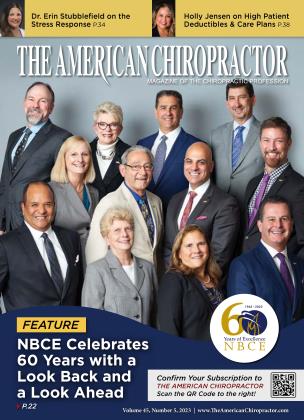Chiropractic Care and Quality of Life
IN BRIEF
Pain Management
Diagnosis and Management of Nonspecific Spine Pain
William J. Owens Jr.
DC DAAMLP CPC
Managing ongoing spine pain can be complex and require effective communication across multiple healthcare professions. It is especially important to prevent unnecessary escalation of care in patients with nonspecific spine pain. One of the ways to measure response to intervention is through quality-of-life measurements. In a recent paper by Salik et al. (2022), the authors wrote, “Quality of life (QoL) instruments facilitate measurement in the evaluation of pain consequences and pain management therapies. Because pain and QoL are interrelated, they share several fundamental characteristics.” (pg2)
“It presents preliminary evidence that chiropractic modalities can have positive effects on quality of life by biopsychosocial perspective”
QoL measurements in the research setting should be validated. In this case, the paper reports, “The World Health Organization’s quality of life short-version survey (WHOQoL-BREF) is a high-quality, patient-reported QoL measure suited to individual assessment in clinics for research and audit.” (pg2) This was the survey used in this research study.
When we look at the source of the spine pain, the article stated, “Nonspecific pain among office workers has gained recognition as a substantial health problem that interferes with quality of life. Prevalence of nonspecific pain has been reported to be as high as 93%.” (pg 1}They continued by outlining, “This type of pain has been termed ‘nonspecific’ because it is defined as pain with no signs or symptoms of major structural pathology, as well as with the absence of neurologic signs and specific pathologies including traumatic sprain and fracture, cancerous, infectious, and inflammatory conditions.” (pg !) Most of the time, we see pain being generated because of biomechanical abnormalities in the spine.
The authors stated, “Evidence indicates that chiropractic care is efficacious for treating nonspecific pain.” (pg5)In this study, a small group of workers were evaluated, “Seventy-seven office workers with nonspecific pain were included in the present study, subjected to chiropractic care and a self-reported WHOQoL-BREF.” (pg2)
The paper continued, “All study participants with nonspecific pain (neck, thoracic, back, and/or extremity pain) received chiropractic care after chief complaint history, physical examination, and radiographic evaluation. Chiropractic treatment approaches for spinal musculoskeletal conditions were based on the region of the disorder according to the chiropractic physician’s decision.” (pg2)
In conclusion, the authors stated, “It presents preliminary evidence that chiropractic modalities can have positive effects on quality of life by biopsychosocial perspective because the WHOQoL-BREF has many facets that interrogate psychological, social, general, and physical health of the individual.” (pg9)When focusing on the diagnosis and management of spine pain, particularly pain of nonspecific origin, we should be looking at a biomechanical source. The chiropractic profession is specifically trained to evaluate and manage the biomechanical conditions related to spine pain and its overall effect on quality of life, not just pain.
Dr. William Owens Jr is currently in private practice in Buffalo, NY. His practice employees 4 Doctors of Chiropractic and 3 Doctors of Physical Therapy. He is President and CEO of the National Spine Management Group, LLC and Clinical Director of the Fellowship in Spinal Biomechanics and Trauma. Additionally, Dr. Owens is Adjunct Faculty in Family Medicine at the State University of New York at Buffalo Jacobs School of Medicine and Biological Sciences and Cleveland University Kansas City, College of Chiropractic. He can be reached at 716-228-3847.
References
1. Salik, E., Ozden, A. V, & Alptekin, H. K. (2022). Chiropractic Care and Quality of Life Among Office Workers with Nonspecific Pain: A Cross-Sectional Study. Journal of Chiropractic Medicine.
 View Full Issue
View Full Issue






